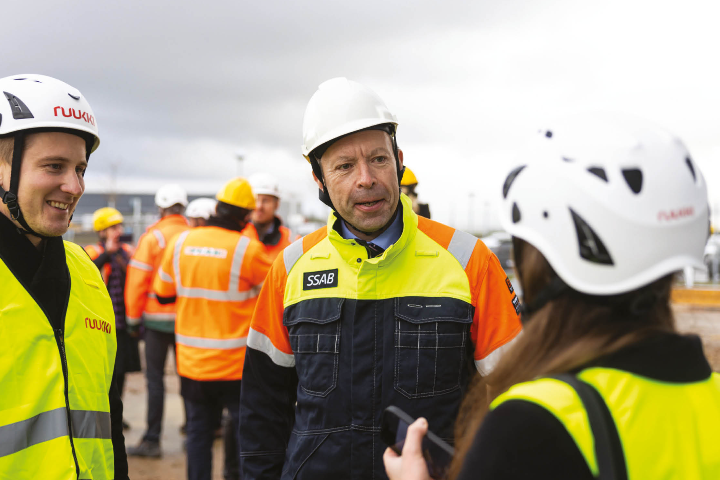
The steelmaking revolution you need to know about
09 April 2025
As the world continues its fight against climate change, some industries are finding themselves at the front line of the battle. The steel industry, which accounts for 7-9% of global CO2 emissions, is one of them. For SSAB — global leader in advanced high-strength steel and SCC UK Patron — tackling this challenge is central to their strategy. With a uniquely Swedish approach that blends innovation and a collaborative mindset, SSAB is working to transform steelmaking whilst creating a more sustainable future for generations to come.
SSAB has been a key player in the UK landscape since the 1970s, contributing significantly to industries like construction and automotive. Today, it’s their commitment to green transformation that is drawing significant attention – particularly with their HYBRIT partnership and introduction of SSAB Zero™, the first decarbonised steel available commercially. Strategic partnerships have been key in making these projects go from idea to reality, and this is how SSAB is proving that collaboration is the key to addressing some of the world’s biggest challenges.
Steel for the greener good
The urgency for change in steel production is growing. "Steel production accounts for 7-9% of global CO2 emissions, making it a significant contributor to climate change," says Thomas Hörnfeldt, VP Sustainable Business at SSAB. "Time is of the essence, and the steel industry must act decisively to align with global climate targets."
At SSAB, the solution isn’t just about reducing emissions in one small area of production — it’s about transforming the steelmaking process from source to the final product. Step-by-step, they work towards phasing out traditional steelmaking methods and transitioning to fossil-free processes, with the goal to largely eliminate fossil emissions from steel production.
Besides doing the right thing for our planet, this transformation is also aiming to meet the growing demand for sustainable materials in industries such as automotive and construction. As electric vehicle fleets increases and energy-efficient buildings become the norm, the pressure to decarbonise materials like steel is intensifying.
“By addressing CO2 emissions at their source, we’re reshaping the steelmaking process," says Thomas, and continues: "our early initiatives, such as SSAB Zero™, position us as a leader in this crucial shift."
A Swedish solution to global issues
One of the key innovations in SSAB’s sustainability journey is HYBRIT (Hydrogen Breakthrough Ironmaking Technology), made possible through a collaboration with two other SCC UK Patrons — leading mining group LKAB and major energy provider Vattenfall. Together, they’ve developed a process that replaces coal with fossil-free hydrogen, enabling steel production with nearly zero CO2 emissions.
"HYBRIT transforms what has historically been a hard-to-abate sector into a near-zero industry. By removing CO2 emissions at the core of steelmaking, we’re creating a sustainable future for the industry," Thomas explains.
The technology is currently being scaled up, with the goal of making fossil-free steel available commercially by the end of 2028. It’s a monumental shift, and SSAB, together with LKAB and Vattenfall, are determined to lead the way – showcasing a Swedish solution to global issues.
Cross-border partners in innovation
SSAB’s partnership with UK-based Firth Steels is another example of how collaboration can drive sustainable innovation. Firth Steels is a leading manufacturer of steel products for wall and roof systems, and they share SSAB’s vision of reducing the climate impact of construction materials.
Together, they are proving that sustainability and industry progress can go hand in hand. A notable example is their work building a Cadet Training Centre for the East Midlands Reserve Forces and Cadets Association, where Firth Steels used SSAB Zero™ in construction. The project not only met a target of 70% recycled materials but also significantly reduced the overall carbon footprint in the process.
"Collaborations with forward-thinking companies like Firth Steels are vital for driving downstream innovation," says David Williams, Managing Director at SSAB UK, and continues: "we’re setting an example of how industries can adapt to the future by prioritising sustainability."
Looking into the future: SSAB’s continued commitment
For SSAB, the journey doesn’t stop with HYBRIT or SSAB Zero™. Their sustainability roadmap is ambitious, and it includes plans for even more innovation in steel production. One of their upcoming milestones is the establishment of their first electric arc furnace-based steel plant in Oxelösund, Sweden, in 2026. This will be followed by a new state-of-the-art mini-mill in Luleå in 2028. These plants will play a crucial role in SSAB’s goal of producing steel with near-zero fossil emissions at scale.
A commitment to long-term partnerships
At the heart of SSAB is their belief in the power that a partnership can hold. "We understand that the big problems we face today – climate change, resource depletion – cannot be solved by one company alone," says David.
These collaborations are critical in driving the industry-wide transformations needed to combat climate change and create a sustainable future for all. David explains: "This is why we’re committed to building long-term relationships with key stakeholders, whether in the automotive, construction, or energy sectors."
SSAB’s journey to sustainability truly is a great example of how partnerships can spark meaningful change. From their pioneering HYBRIT partnership to their collaboration with Firth Steels, SSAB is showing the world that when companies come together, they can make a real impact on some of the planet’s biggest challenges.
As David himself puts it, "The future of steel is fossil-free, and we’re determined to make it a reality. Together, we can build a stronger, lighter, and more sustainable world."



